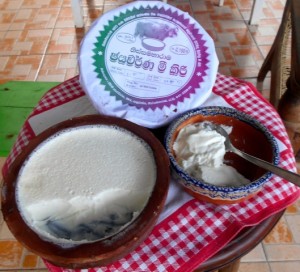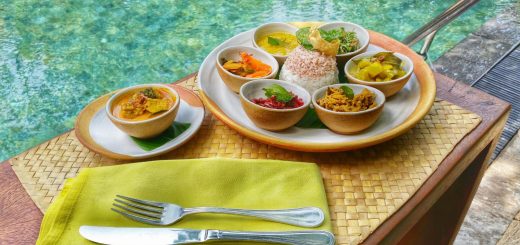SRI LANKA ROUNDABOUT (Number 20) – Buffalo Curd
by · Published · Updated
A weekly look at Sri Lanka for Jetwing by Royston Ellis
Welcome to Jetwingers around the world to this week’s issue of my regular Jetwing newsletter about Sri Lanka.
While driving on the way to or from Tissamarahama, Kataragama or Yala on the A2 main road in the south, you’re sure to see wayside stalls with stacks of clay pots on display. Sometimes these pots, strung together, hang from the branches of trees. As additional emphasis about the product on sale, there might also be the whitened skull of a horned buffalo.
These stalls are selling a local delicacy: buffalo curd. The stalls are densest around the villages of Wirawila and Andalla, between the 250km and 260km markers (showing the road distance from Colombo). This is the heart of Sri Lanka’s real curd industry. Thanks to commercial methods of production, you can buy buffalo and cow curd in plastic containers in supermarkets throughout Sri Lanka. You’ll also see curd on sale in clay pots in Galle and Matara, but for the authentic taste of traditional Sri Lanka curd, try it fresh from the village producers of the southern plains.
Traditionally buffalo curd (it’s thicker and tastier and has a higher fat content than cow’s curd) is made from filtered and boiled buffalo milk. Curd is believed to have been made in the Tissamaharama district for centuries; it is said the Portuguese liked it so much they carried curd from Sri Lanka’s south on voyages home.
Over 400 families in the villages of Wirawila and Andalla survive and thrive on buffalo curd. The natural manufacturing process begins with a female buffalo bring milked by hand. A couple of litres of milk is enough and this is strained to remove scum and then poured straight into a cauldron-like pot sitting on a wood fire. The milk must be fresh. It is boiled and stirred for about two hours, reducing the water content by about 20 percent.
Now comes the part that might upset the squeamish – the addition of a starter to act as the souring agent to set the milk a-curdling. Traditionally, the clay pot into which the boiled milk is poured was swilled around with buffalo’s urine. Other agents, such as tamarind pulp or natural microbes are used now, but the usual (and less unpleasant) method is to add a spoonful of previously made buffalo curd as the starter.
The traditional container for curd (in which it is sold in villages) is a locally made brownish red, earthenware pot of baked clay, known as terracotta. The milk is poured into the container and sealed with a paper lid and left to cool and set for five to 12 hours. It can keep like that for two days, and for longer after you’ve bought it and put it in a refrigerator.
Sri Lankans call curd “Meekiri” and think the only way to eat it is with liberal helpings of sweet kithul treacle, made from the boiled sap of the kithul palm, as a dessert or breakfast dish. However, curd can also be eaten plain as it has a wholesome, feel good, taste. Villagers selling curd are happy to let visitors sit by their stalls and consume a whole pot; it’s so delicious it makes mass produced yoghurt forever seem insipid.
Royston Ellis (www.roystonellis.com) is a British author resident in Sri Lanka since 1980





